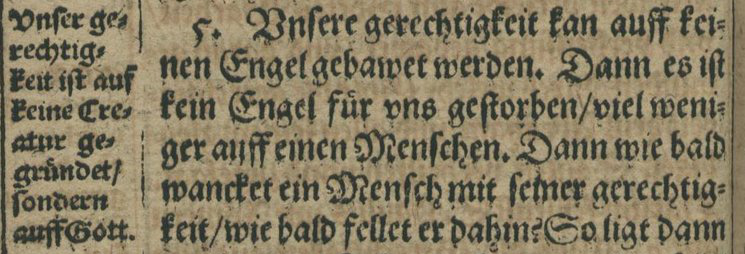Marginal Notes (Marginalia)
The <note> element is used to tag marginal notes, as well as footnotes and endnotes. The @place attribute can take the values right and left, which specify the position of the marginal note in relation to the text area.
<note place="right">[marginalia to the right of the text]</note> <note place="left">[marginalia to the left of the text]</note>
Marginalia to the right of the text (@place="right") are transcribed immediately after the line they are on a level with, while marginalia to the left of the text (@place="left") are transcribed immediately before the line they are on a level with.
Encoding of Marginalia at the Left Margin

<p>Der folgende Kaiser, <hi rendition="#k">Yuṅ-tšin</hi>, vertrieb bei seiner Thron-<lb/> <note place="left"> 1723. </note> besteigung 1723 alle Missionare als Ruhestörer. Einige hielten sich<lb/> [...] </p>
Source: [Berg, Albert]: Die preussische Expedition nach Ost-Asien. Bd. 3. Berlin, 1873. [Facsimile 36]
Encoding of Marginalia at the Right Margin

<p>[...]<lb/>
Die Todtenopfer und andere Gebräuche, welche er als bürgerliche<lb/>
duldete, wurden von den Dominicanern als götzendienerisch ver-<lb/>
dammt und allen chinesischen Christen unter Androhung der Höllen-
<note place="right">
1644.
</note><lb/>
strafen verboten. Papst Innocenz X. bestätigte dieses Urtheil, das
<note place="right">
1655.
</note><lb/>
Alexander VII. auf Vorstellung der Jesuiten wieder aufhob. Die<lb/>
[...]
</p>
Source: [Berg, Albert]: Die preussische Expedition nach Ost-Asien. Bd. 3. Berlin, 1873. [Facsimile 35]
If a marginalia is located on the left margin directly at the beginning of a new paragraph, it will be displayed within the <p>-element.
Encoding of Marginalia at the Beginning of a New Paragraph

<p> <note place="left"> Vnſer ge-<lb/> rechtig-<lb/> keit iſt auf<lb/> keine Cre-<lb/> atur ge-<lb/> gruͤndet/<lb/> ſondern<lb/> auff Gott. </note> 5. Vnſere gerechtigkeit kan auff kei-<lb/> nen Engel gebawet werden. Dann es iſt<lb/> [...] </p>
Source: Arndt, Johann: Vom wahren Christenthumb. Bd. 2. Magdeburg, 1610. [Facsimile 64]
If a marginal note has been assigned to the text, it is possible (level 3) to reproduce this reference in the same way as for the tagging of end notes. The marginal note is transcribed as described above. The <note> element, which encloses the marginal, contains a @n attribute, which receives the reference mark of the marginal note. The corresponding reference mark in the text is enclosed with an untyped <note> element. Both <note> elements are linked with each other with @xml:id and @corresp (see chap. 4.2.2).
<p>
[text beginning of line]
<note n="[reference]" xml:id="[ID-reference]" corresp="#[ID-marginal note]"/>
[text end of line]
<note place="right" n="[reference]" xml:id="[ID-marginal note]" corresp="#[ID-reference]">[marginal note]</note>